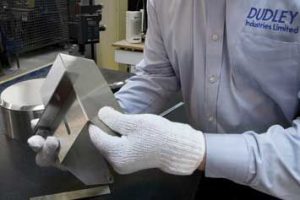A guide on how to clean stainless steel

March 1, 2023
Cleaning stainless steel appliances and surfaces
One of the key features of a stainless steel surface, such as those found on hobs, stainless steel sink, and soap dispensers is their low maintenance and how easy they are to clean.
Just a few simple steps undertaken as part of a regular cleaning routine will keep your stainless steel surfaces in tip top condition, and help to present a clean and hygienic kitchen and washroom your home or business.
Create a regular regime to clean stainless steel appliances along with your surfaces. These may include stainless steel sinks, stainless steel pots, or a stainless steel refrigerator.
What is the best thing for cleaning stainless steel?
A simple mild, diluted detergent wiped, rinsed and dried is all it takes to keep on top of daily dust, fingerprints and water splashes.
- Use a soft cloth or sponge and wipe in the direction of the brushed grain for best results.
- Use a mild detergent and soft cloth
- Do NOT use chemicals, bleach or abrasive cleaners
Do I need to buy commercial stainless steel cleaner?
There is no requirement to use commercial stainless steel cleaners, or use any chemical cleaning products, bleach or abrasive cleaners. Some specialist stainless steel cleaning formulations are available on the market. These should be fine, but as we cannot test every product available we always recommend that you undertake a spot test first.
Top tips on how to clean stainless steel
Make stainless steel look new again with our simple cleaning tips:
- Read the manufacturer's instructions on all stainless steel appliances before you clean them. Some products may have special protective coatings which require special care
- Ensure to wipe away any surface dust or debris with a soft, clean cloth. We recommend microfiber cloths which remain soft and gentle on surfaces after many washes
- Do not use harsh, abrasive cleaners or scouring pads on stainless steel surface
- When you have finished cleaning, wipe along the grain with soft tissue or kitchen roll to make stainless steel shine like new!
How to remove fingerprints on stainless steel
Remove unsightly fingerprints from stainless steel surfaces with ease using a mild soap or detergent and a soft cloth, and polish with soft tissue to restore the shine of your surfaces.
If you have stainless steel dispensers or handles in your washroom or home, then you will be well aware of the dreaded fingerprint mark. Toilet roll holders, soap dispensers and door and cupboard handles are all inevitably touched by users. This often leaves behind a greasy fingerprint mark, even on plastic dispensers.
If this is a persistent problem, consider installing dispensers that provide the superior look and feel of stainless steel, but have a coating that helps to prevent such marks. Our Platinum Range of washroom products uses an innovative lacquer applied directly onto the stainless steel that helps to prevent fingerprint marks keeping your washroom looking pristine and reducing the demands placed on your cleaning teams.
Cleaning a top up soap dispenser
A top up stainless steel soap dispenser provides a cost effective solution to ensure your visitors never face the feared empty refill. However, in quieter washrooms where a dispenser may not have been used for a while the soap can dry and clog in the nozzle.
On the rare occasion that this might happen we recommend adding warm water to the reservoir and pressing the pump until the blockage clears. Do not add any cleaning products to the reservoir to avoid any contamination with the soap.
Please DO NOT EVER attempt to push a sharp object into the nozzle; this can cause damage to the unit and injury to you. Simply add hot water and clear it that way.
Is my stainless steel dispenser rusty? – highly unlikely
If you find any brown spots or deposits around the lid, pump, sides or bottom of stainless steel dispensers, you may think this is rust. This is highly unlikely. It is much more likely to be a build-up of soap that simply needs removing. In these cases, we recommend removing the deposit with a brush or non-scratch cleaning pad and warm soapy water, always rinsing and drying well. This will return your unit to its best condition and appearance.
What should you not use on stainless steel?
A quick internet search provides rather more ‘interesting' solutions to keep stainless steel shiny, such as wax paper, baking soda, dish soap, glass cleaner, vinegar (vinegar damage stainless steel), steel wool, and olive oil! But what is interesting is that most of these articles all finish with a recommendation of simple mild detergent and microfiber cloth, which is definitely what the Dudley Industries team would recommend.
How often should you clean stainless steel?
Never underestimate the influence that the first impression of your washroom can have on your company and brand. Most of us will judge, often unconsciously, a business by the standard of its washroom.
A pristine, fresh smelling, hygienic washroom demonstrates a level of attention and care provided to colleagues and visitors alike. An unpleasant, smelly, dirty washroom can quickly unravel the brand image and company values presented in reception. Obviously the regime for your cleaning team will depend on the size of your washrooms and footfall. We recommend as a minimum that the outer surface of a dispenser is cleaned daily. Inside surfaces should be wiped clean with soap and water at least once a week.
Further Product Care Guidance
Find more advice on how to care for your stainless steel washroom products or if you would prefer to speak to one of our team then please call +44 (0) 1253 738311 or email sales@dudleyindustries.com